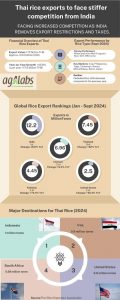Thailand’s rice export industry is bracing for increased competition following India’s decision to lift its export restrictions and taxes on rice, effective September 28, 2024. This move allows India to resume unlimited rice exports, positioning it to reclaim a dominant share of the global rice market.
India, the world’s largest rice exporter, shipped a record 12.2 million tonnes of rice in the first nine months of 2024, despite a 19.6% year-on-year decline in exports. Thailand, which remains in second place, exported 7.45 million tonnes during the same period, marking a 22% increase compared to last year. However, with the removal of India’s export restrictions, Thailand now faces tougher competition in global markets, especially in regions where India has traditionally been strong.
The re-entry of India into the unrestricted export market could pose challenges to Thailand’s long-established export markets, particularly in Africa and Southeast Asia, where price-sensitive buyers may turn to India for more competitive prices. India’s return to the export scene may push Thai rice prices lower, especially for mainstream varieties, while India also looks to expand its presence in high-demand regions such as Indonesia, Iraq, and the Philippines—countries that have historically been strong buyers of Thai rice.
In terms of value, Thailand’s rice exports reached 5.04 billion USD in the first nine months of 2024, reflecting a 45.8% increase compared to last year. The country has continued to enjoy strong demand for fragrant rice and premium white rice, which make up a significant portion of its export market. Exports of Hom Mali fragrant rice have remained resilient, with shipments to markets like Iraq, Japan, and Kenya continuing to perform well.
However, Thailand’s exports of parboiled rice have faced a notable decline, down 30% compared to the same period in 2023. With India poised to ramp up its rice exports, it is anticipated that Thailand will face further pressure in this segment, especially given India’s ability to offer rice at competitive prices.
The largest importer of Thai rice this year has been Indonesia, followed by Iraq, the US, South Africa, and the Philippines. As India resumes its unrestricted exports, these markets could become increasingly competitive, with Indian rice flooding international markets at potentially lower prices, challenging Thailand’s market share.
With the lifting of export bans, India’s impact on the global rice trade is expected to intensify, and Thailand’s rice industry will need to adapt to the new competitive landscape. The country’s continued strength in premium rice exports may help mitigate some of the pressure, but the coming months will likely see tighter competition between the two rice giants. (Source: Thai Rice Exporters Association)
